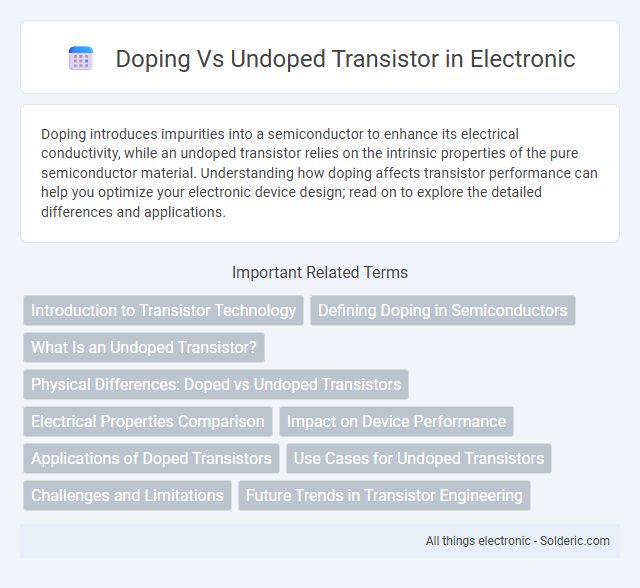Doping introduces impurities into a semiconductor to enhance its electrical conductivity, while an undoped transistor relies on the intrinsic properties of the pure semiconductor material. Understanding how doping affects transistor performance can help you optimize your electronic device design; read on to explore the detailed differences and applications.
Comparison Table
| Feature | Doping Transistor | Undoped Transistor |
|---|---|---|
| Definition | Transistor with intentional impurity atoms added to modify electrical properties. | Transistor without added impurities, relying on intrinsic semiconductor properties. |
| Charge Carrier Concentration | High, due to dopant atoms providing free electrons or holes. | Low, intrinsic carrier concentration only. |
| Conductivity | Enhanced conductivity from dopants. | Lower conductivity, limited by intrinsic semiconductor behavior. |
| Control | Precise electrical characteristics through doping levels. | Less control, dependent on external electric fields or workfunction engineering. |
| Fabrication Complexity | Requires doping steps during manufacturing (ion implantation or diffusion). | Simpler fabrication, eliminates doping process. |
| Leakage Current | Higher leakage due to dopant-induced defects. | Lower leakage, improved off-state characteristics. |
| Example Use Cases | Conventional CMOS technology, high-performance devices. | Advanced low-power transistors, nanoscale FETs. |
Introduction to Transistor Technology
Transistor technology relies heavily on the manipulation of semiconductor materials to control electrical conductivity. Doped transistors incorporate impurities like phosphorus or boron to create p-type or n-type regions, enhancing their ability to switch and amplify signals efficiently. Undoped transistors, by contrast, use pure semiconductor material, which limits charge carrier availability and reduces overall device performance, making doping a critical factor in modern electronic circuit design for optimizing speed and power consumption.
Defining Doping in Semiconductors
Doping in semiconductors involves intentionally introducing impurities into intrinsic materials like silicon to modify electrical properties, enhancing conductivity by increasing charge carriers. Undoped or intrinsic transistors rely solely on pure semiconductor material, resulting in lower conductivity and limited control over electrical characteristics. The doping process defines transistor behavior by creating n-type or p-type regions crucial for efficient current flow and switching performance in electronic devices.
What Is an Undoped Transistor?
An undoped transistor is a semiconductor device made without intentional introduction of impurities, relying on intrinsic material properties to control electrical behavior. Unlike doped transistors, which use elements like boron or phosphorus to modify conductivity, undoped transistors maintain purity to reduce variability and improve performance at nanoscale dimensions. This approach enables better control over electron flow and enhances device stability in advanced integrated circuits.
Physical Differences: Doped vs Undoped Transistors
Doped transistors contain intentionally introduced impurities, such as boron or phosphorus atoms, to modify the semiconductor's electrical properties by increasing charge carrier concentration, which enhances conductivity. Undoped transistors, made from pure semiconductor material like intrinsic silicon, rely on external electric fields to control current flow without altering the material's intrinsic properties. The physical difference manifests in the presence of localized regions with altered charge densities in doped transistors, influencing threshold voltage, while undoped transistors exhibit uniform material composition and different electrical characteristics.
Electrical Properties Comparison
Doped transistors exhibit enhanced electrical conductivity due to the introduction of impurity atoms, which increase charge carrier concentration and reduce resistivity compared to undoped transistors. Undoped transistors typically have higher threshold voltages and lower leakage currents, resulting in better performance in low-power applications but reduced drive current capabilities. The doping process directly influences key parameters such as carrier mobility, on/off current ratio, and switching speed, making doped transistors more suitable for high-performance electronic devices.
Impact on Device Performance
Doping significantly enhances transistor performance by increasing charge carrier concentration, which reduces resistance and boosts current flow, leading to faster switching speeds and improved conductivity. Undoped transistors exhibit higher resistivity and lower carrier mobility, resulting in slower operation and higher power consumption. The dopant concentration and distribution directly influence threshold voltage, leakage current, and overall device reliability in semiconductor technologies.
Applications of Doped Transistors
Doped transistors, enhanced with precise impurity atoms, enable control over electrical conductivity, making them ideal for high-performance digital circuits, analog amplifiers, and radio frequency applications. Their tailored electrical characteristics allow for optimized switching speeds and power efficiency in microprocessors and memory devices, critical for modern electronic systems. You benefit from doped transistors in devices requiring reliable signal amplification and stable operation under varying environmental conditions.
Use Cases for Undoped Transistors
Undoped transistors offer superior performance in low-power and high-frequency applications due to their reduced impurity scattering and enhanced carrier mobility. They are ideal for quantum computing and sensitive analog circuits where minimal noise and precise control over electrical characteristics are crucial. Your designs benefit from undoped transistors by achieving higher efficiency and improved signal integrity without the variability introduced by doping impurities.
Challenges and Limitations
Doping in transistors introduces impurities to enhance conductivity, but it faces challenges such as increased leakage current and variability at nanoscale dimensions, impacting device reliability. Undoped transistors, relying on intrinsic semiconductor properties, offer reduced short-channel effects and improved scalability but struggle with lower drive current and threshold voltage control. Balancing doping and undoped approaches is crucial for optimizing performance while overcoming limitations like power efficiency and fabrication complexity in modern semiconductor technology.
Future Trends in Transistor Engineering
Future trends in transistor engineering emphasize the transition from traditional doped silicon devices to undoped or lightly doped structures to enhance performance and scalability. Innovations such as intrinsic channel transistors and alternative materials like silicon nanowires and two-dimensional semiconductors enable reduced short-channel effects and lower leakage currents, improving energy efficiency in nanoscale devices. Research advances in atomically precise doping techniques and novel electrostatic control methods are driving the development of transistors with superior switching speeds and minimized variability for next-generation computing technologies.
Doping vs Undoped transistor Infographic

 solderic.com
solderic.com